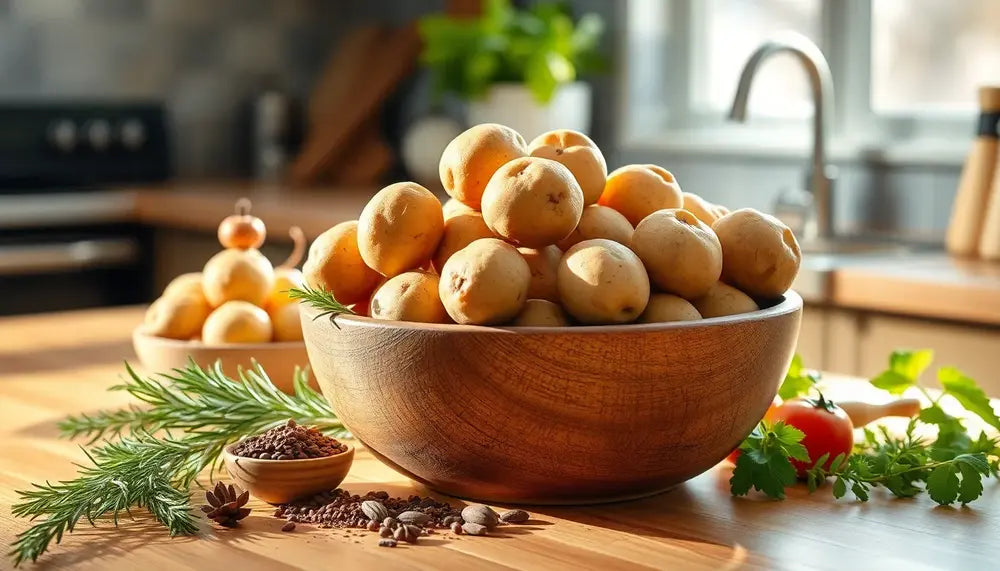Introduction to allspice: The spice with a twist
Allspice, also known as clove pepper or all-spice, is a unique spice valued in many cuisines worldwide. It comes from the berries of the evergreen allspice tree and combines the flavors of cinnamon, nutmeg and cloves in a single spice.
The versatility of allspice makes it an essential ingredient in the kitchen. Whether in savory dishes or sweet baked goods – allspice gives every recipe a special touch. Its flavor is intense and complex, making it ideal for a variety of uses.
In this article, we'll take a closer look at the origins, botany, culinary uses, and health benefits of allspice. You will learn everything you need to know about this fascinating spice and how you can use it in your kitchen.
Origin and history of allspice
Allspice, scientifically known as Pimenta dioica, has its roots in Central America and the Caribbean. The allspice tree grows primarily in countries such as Jamaica, Guatemala and Honduras. These regions provide the best climatic conditions for the growth of this special spice.
The discovery by Christopher Columbus
The history of allspice in Europe began in 1492, when Christopher Columbus came across this spice during his voyage to the New World. He brought it back to Spain, where it quickly gained popularity. It was called “new spice” because it opened up a completely new dimension of taste.
Allspice in stores
Over time, Jamaica became the main growing region for allspice. Today around two thirds of the world's allspice production comes from this island. The export of allspice is an important industry for Jamaica, and the country prides itself on the high quality of its product.
Cultural significance
Allspice not only has culinary significance, but also cultural roots in the growing regions. In Caribbean cuisine it is often used in traditional dishes and is an integral part of many recipes. Allspice has also established itself in Europe, particularly in Christmas baking and in the production of sausages.
The botany of the allspice tree
The allspice tree, also known as Pimenta dioica, is an evergreen tree that belongs to the myrtle family. It can reach a height of 10 to 12 meters and has a trunk diameter of around 30 to 40 centimeters. The tree's bark is light grayish and gives it a characteristic appearance.
Leaves and flowers
The leaves of the allspice tree are arranged oppositely and are about 15 to 20 centimeters long. They are elongated oval and have a shiny, dark green surface. The tree's small white flowers are about 0.8 centimeters in diameter and grow in dense clusters.
fruits
The spherical berries of the allspice tree have a diameter of 0.5 to 0.8 centimeters. They are initially green and turn dark brown when ripe. These berries contain the valuable spice allspice. The fruits are harvested unripe and then dried to reveal their full flavor.
Growing areas
The allspice tree thrives best in tropical climates with high humidity. Jamaica is the main allspice producing region, followed by other countries in Central America and the Caribbean. The tree prefers well-drained soil and sunny locations.
Due to its impressive size and dense leaves, the allspice tree also makes a valuable contribution to the ecosystem of its growing regions. It provides shade and protects the soil from erosion.
Culinary uses of allspice
Allspice is a spice used in many cuisines around the world. Its complex flavor, reminiscent of a mixture of cinnamon, nutmeg and cloves, makes it a versatile ingredient in many dishes. Here are some of the most common culinary uses of allspice:
Seasoning meat and fish
Allspice is often used to season meat and fish dishes. In Caribbean cuisine, it is an important ingredient in marinades and spice mixtures for jerk chicken or jerk pork. Allspice can also be found in European cuisine in recipes for roasts, stews and sausages.
Baked goods and desserts
Allspice is particularly popular in sweet baked goods and desserts. It gives Christmas cookies such as gingerbread, speculoos and stollen a distinctive taste. Allspice also provides a warm, spicy note in cakes, tarts and cookies.
Sauces and soups
Allspice can also refine sauces and soups. A pinch of allspice in tomato sauce or stew adds depth and complexity to the dish. It goes particularly well with pumpkin or carrot soups.
International specialties
Allspice also has many uses in international cuisine. In Indian biryani it provides a rich flavor, while in Mexican mole it provides the necessary spice. Allspice also plays an important role in Jamaican Easter bread.
Drinks
Allspice can even be used in drinks. A small amount of this spice in hot apple cider or mulled wine brings additional warmth and spice to the glass.
Allspice is a real all-rounder in the kitchen. With its unique taste, it enriches both savory and sweet dishes and should therefore not be missing from any spice collection.
Medicinal Benefits of Allspice
Allspice is not only a versatile spice in the kitchen, but also has various medicinal benefits. The essential oils and active ingredients contained in allspice can help with various health problems.
Antibacterial effect
A main component of allspice is eugenol, an essential oil with strong antibacterial properties. This property makes allspice useful in fighting bacteria and can help prevent or relieve infections.
Relief from digestive problems
Allspice can help relieve digestive symptoms such as bloating, stomach cramps, and diarrhea. A small amount of allspice in food or prepared as a tea can aid digestion and reduce stomach upset.
Pain relief
The anesthetic effects of eugenol also make allspice useful in relieving toothache. A paste of ground allspice and water applied to the painful tooth can provide short-term relief.
Anti-inflammatory
Allspice contains anti-inflammatory compounds that may be helpful in treating muscle and joint pain. Applying allspice oil externally can relieve pain and reduce inflammation.
Use for colds
Because of its warming properties, allspice is also often used to relieve cold symptoms. A hot tea made from allspice berries can soothe a sore throat and clear the respiratory tract.
Allspice not only offers taste benefits, but also a number of health benefits. It is therefore worth having this spice not only in the kitchen, but also in the medicine cabinet.
Allspice in international cuisine
Allspice is a spice that is used in various cuisines around the world. Its unique taste makes it a popular ingredient in many traditional dishes. Here are some examples of how allspice is used in international cuisine:
Caribbean cuisine
Allspice is an indispensable spice in Caribbean cuisine. It is often used in marinades for meat dishes such as jerk chicken or jerk pork. Allspice also adds an aromatic note to soups and stews.
Indian cuisine
In India, allspice is often used in rice dishes such as biryani. It gives the dish a deep, complex flavor. Allspice can also be found as an ingredient in various curries and masalas.
Mexican cuisine
In Mexico, allspice is an important ingredient in mole, a rich sauce made from chocolate, chilies, and spices. It gives the sauce a special depth and complexity.
Mediterranean area
In the Mediterranean, allspice is often used in spice blends such as Ras el Hanout, which are used in North African dishes. Allspice can also be found in various recipes in Spain and Italy.
Northern European cuisine
In Northern Europe, especially in Scandinavia and Germany, allspice is a popular winter and Christmas spice. It is often used in gingerbread, mulled wine and other festive recipes.
Allspice shows its versatility through its use in numerous international cuisines. Whether savory or sweet – this spice enriches every dish with its unique aroma.
Allspice oil: extraction and use
Allspice oil is an essential oil extracted from the fruits or leaves of the allspice tree. This oil has numerous uses in both cooking and medicine. Here you can find out how allspice oil is obtained and what it can be used for.
Extraction of allspice oil
Allspice essential oil is obtained primarily through steam distillation. The dried berries or leaves of the allspice tree are used. In a still, water vapor is passed through the plant material, releasing and condensing the essential oils.
The distillation process takes several hours and requires a lot of care to ensure the quality of the oil. The resulting allspice oil has a balsamic-spicy to peppery scent and a yellowish color.
Culinary uses of pimento oil
Allspice oil can be used in small quantities to season dishes. A few drops of this intense oil are enough to add a special flavor to sauces, soups and marinades. However, it should be dosed sparingly as it is very concentrated.
Medicinal use of allspice oil
Allspice oil has various health benefits and is often used in aromatherapy. It can help with muscle and joint pain when applied topically. A massage with diluted allspice oil can relieve pain and reduce inflammation.
Allspice oil can also be useful for colds. A few drops in a steam bath or diffuser can clear the airways and provide relief. The oil also has antibacterial and anti-inflammatory effects.
Be careful when using
Since allspice oil is very strong, it should always be used diluted. In its pure form it can cause skin irritation. It is advisable to carry out a patch test before use to rule out allergic reactions.
Allspice oil offers many options for use in the kitchen and medicine cabinet. With its intense flavor and health benefits, it is a valuable product that can be used in many ways.
Conclusion: Why allspice should be in every kitchen
Allspice is a spice that enriches every kitchen. Its versatile uses and unique taste make it an indispensable ingredient in many recipes. But that's not all that allspice has to offer.
Culinary versatility
Whether in savory dishes such as meat and fish marinades or in sweet baked goods - allspice gives every dish a special touch. Its ability to complement both savory and sweet flavors makes it an all-rounder in the kitchen.
Health Benefits
In addition to its taste, allspice also offers health benefits. It has antibacterial, anti-inflammatory and pain-relieving properties. These make it useful for relieving digestive problems, muscle and joint pain, and cold symptoms.
International popularity
The use of allspice in various international cuisines shows its worldwide popularity. From Caribbean to Indian cuisine - this spice finds its place everywhere and contributes to culinary diversity.
Easy to use
Allspice is easy to use and can be used whole or ground. A little bit is often enough to achieve the desired flavor, making it economical to use.
In summary, allspice is a spice with many benefits. It combines taste, health benefits and versatility in one. Therefore, no kitchen should be without it - be it for everyday dishes or special occasions.
FAQ about allspice - the universal spice
What is allspice?
Allspice, also known as clove pepper or all-spice, is a spice obtained from the berries of the evergreen allspice tree and combines the flavors of cinnamon, nutmeg and cloves.
Where does allspice come from?
Allspice comes from Central America and the Caribbean, particularly Jamaica, which today supplies around two-thirds of the world's allspice production.
How is allspice used in cooking?
Allspice is used in many international cuisines to flavor meat and fish dishes, baked goods, sauces, soups and even drinks. It adds a special touch to both savory and sweet dishes.
What health benefits does allspice have?
Allspice contains eugenol, which has antibacterial, anti-inflammatory and pain-relieving properties. It can help with digestive problems, toothaches, cold symptoms and muscle and joint pain.
How is allspice essential oil obtained and used?
Allspice essential oil is obtained by steam distillation of the dried berries or leaves of the allspice tree. It is used in cooking to flavor food and has medicinal uses such as relieving pain and inflammation.





Share:
Bay leaf spice: The Mediterranean touch for meat dishes
Exotic spices from India: Discover the diversity of Indian cuisine